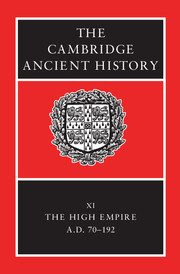Book contents
- Frontmatter
- PART I NARRATIVE
- PART II GOVERNMENT AND CIVIL ADMINISTRATION
- 4 The emperor and his advisers
- 5 Emperor, Senate and magistrates
- 6 The growth of administrative posts
- 7 Provincial administration and finance
- PART III THE EMPIRE
- PART IV ROME, ITALY AND THE PROVINCES
- PART Va ECONOMY AND SOCIETY
- PART Vb ART AND CULTURE
- Chronological Table
- BIBLIOGRAPHY
- Index
- 1 The Roman world in the time of Marcus Aurelius
- 7 The Danube provinces
- References
7 - Provincial administration and finance
from PART II - GOVERNMENT AND CIVIL ADMINISTRATION
Published online by Cambridge University Press: 28 March 2008
- Frontmatter
- PART I NARRATIVE
- PART II GOVERNMENT AND CIVIL ADMINISTRATION
- 4 The emperor and his advisers
- 5 Emperor, Senate and magistrates
- 6 The growth of administrative posts
- 7 Provincial administration and finance
- PART III THE EMPIRE
- PART IV ROME, ITALY AND THE PROVINCES
- PART Va ECONOMY AND SOCIETY
- PART Vb ART AND CULTURE
- Chronological Table
- BIBLIOGRAPHY
- Index
- 1 The Roman world in the time of Marcus Aurelius
- 7 The Danube provinces
- References
Summary
In the summer of a.d. 110, following a decree of the Senate, Trajan sent the senator C. Plinius Secundus, who had already been consul some ten years earlier, on a special commission to the province of Pontus-Bithynia in Asia Minor. In his first letter to Pliny after he had arrived in the province, Trajan describes the task of his appointee and says that it should be made clear to the provincials that Pliny had been sent to them as his representative. The idea lying behind this, that the emperor was the ideal representative of Rome in the provinces, and in practice the necessary representative with ultimate responsibility, was not new. The basis for the special mission in the East entrusted to the prince Germanicus under Tiberius was that the situation in the overseas provinces demanded the presence of the princeps or one of his two sons. However, it was not just at Rome that the emperor was seen, in terms of power politics and law, as the centre of all political and administrative business, but also among the inhabitants of the provinces. It is not chance that Dio Chrysostom, a leading member of the provincial aristocracy in Bithynia, used so many vivid images in describing Trajan. The emperor is compared to the sun, working constantly on behalf of mankind. He is also a shepherd who cares for the welfare of his flock, or a bull who rules over and cares for his offspring in a friendly way. A few decades later, under Antoninus Pius, Aelius Aristides characterized the ruler in Rome as the prytanis of the whole empire, on whom everyone, including his legates, was dependent.
- Type
- Chapter
- Information
- The Cambridge Ancient History , pp. 266 - 292Publisher: Cambridge University PressPrint publication year: 2000
References
- 41
- Cited by

